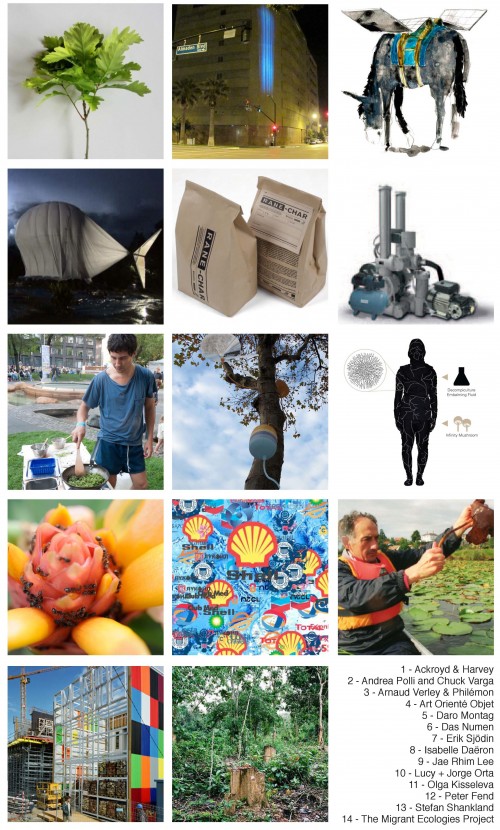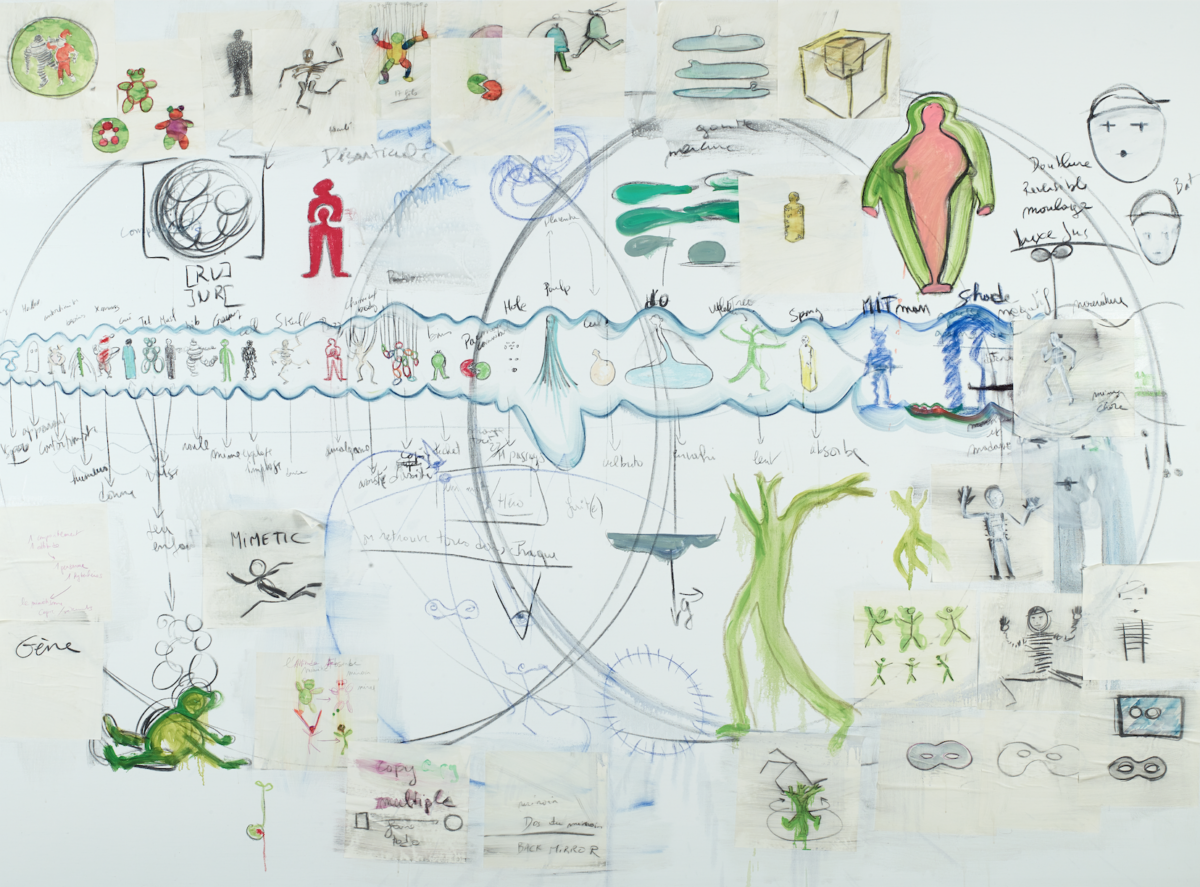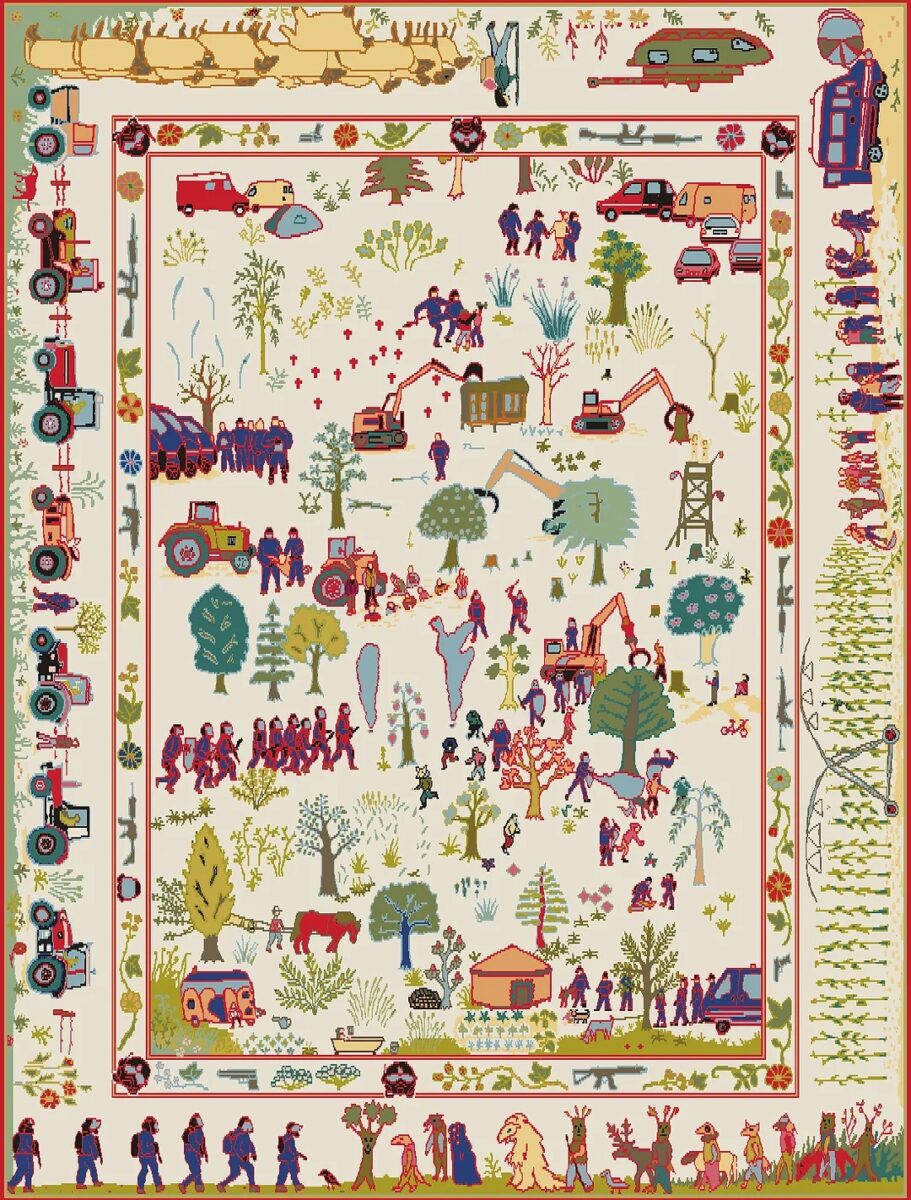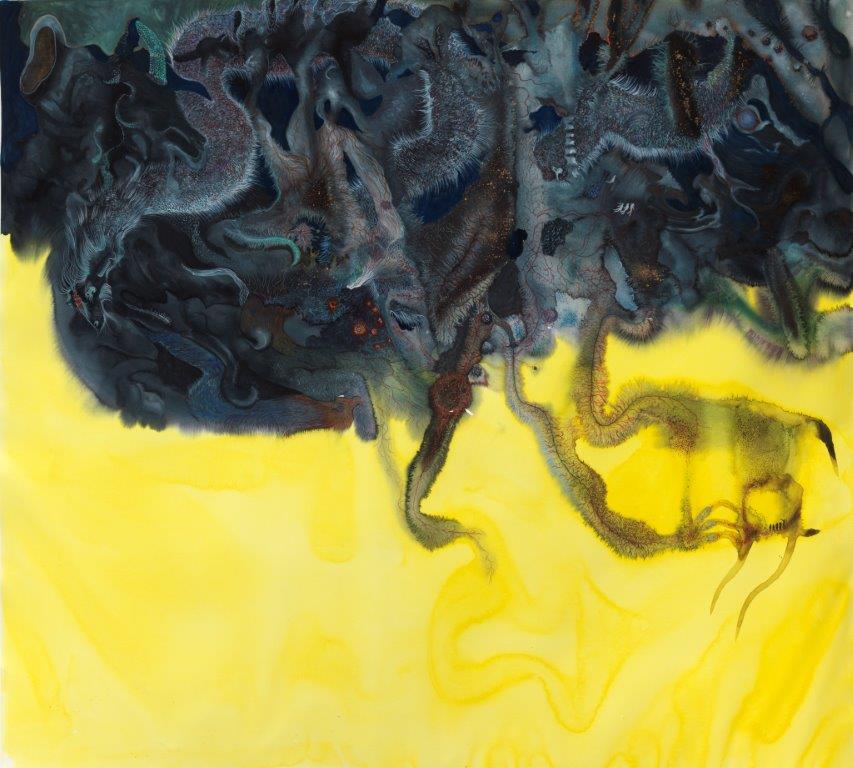
COAL PRIZE 2024 CALL FOR PROJECTS: BEING TRANSFORMATIVE
At a time when knowledge alone is no longer enough to motivate action, the Prix COAL 2024 calls for transformation…
Published on 25 May 2011
They were selected by a selection committee composed of :
Patrick Degeorges, Project Manager, Water and Biodiversity Directorate, Ministry of Ecology;
Eva Hober, Director of the Eva Hober Gallery;
Sacha Kagan, Founder of the Cultura21 Network;
Sylvain Lambert, Partner, Sustainable Development Department, PwC;
Elisabeth Reiss, Director of Ethicity;
Billy Suid, Coal Private Donor;
Céline Roblot, e.g. Sustainable Development Officer, Ministry of Culture ;
Theresa von Wuthenau, Imagine2020 Coordinator and Spokesperson
The COAL team.
>> Download the Coal Prize Catalogue 2011
PRESENTATION OF PROJECTS
BEUYS’ ACORNS by ACKROYD & HARVEY
In 2007, Ackroyd & Harvey collected and germinated a hundred acorns from the 7,000 oak trees planted by Joseph Beuys. They gave birth to 250 young trees. Their project is to care for these descendants with tenacity and to embrace Beuys’ statement that cities and towns should be “like forests”.
Emerging science shows how crucial forests are to the long-term health of cities: a 10% increase in tree cover can keep temperature increases below 4°C and make cities invulnerable to climate change until 2080. The artists are collaborating on Dr. Roland Ennos’ tree project at the University of Manchester and the Oxford ECI at Wytham Woods.
Beuys’ Acorns acts as a catalyst, generating a series of public interfaces around these young trees, led by artists, scientists, lawyers, architects and writers who reveal the fundamental interdependence that unites us with the natural world. It is a lever for emerging science and an attempt to significantly influence environmental policy. As the trees mature, the artists envision massive plantings in particularly tree-poor English cities. Aesthetically, it is a call to cover our cities with trees and plants, in order to prepare ourselves for an uncertain future. Instead of 7,000 trees, the artists are calling for 7 million to be planted across cities in England and Europe.
Ackroyd & Harvey are a duo created in 1990. They live and work in London, UK
PARTICLE FALLS by ANDREA POLLI & CHUCK VARGA
Particle Falls is a projection that interacts with the environment and allows passers-by to appreciate in real time the level of micro-particles in the air. It takes the form of a waterfall falling on the façade of a building.
A recent study commissioned by the Mayor of London shows that 4300 people die prematurely each year because of poor air quality in London (BBC News, Sunday, 28 March 2010). Recent technologies can assess the levels of fine particles in the air in real time. Global monitoring of microparticle pollution is one of the most recent developments in aeronomy. This project includes a nephelometer (in a collaboration with Sonoma Technologies/AirNOW), which measures the smallest particles. Less shiny particles on both sides of the waterfall
means fewer particles in the air.
This consumer installation acts as a monitoring station, an alarm and a source of beauty all in one. Particle Falls can be adapted to any site and ideally works in conjunction with local monitoring services.
Andrea Polli & Chuck Varga have been collaborating since 1999. They live and work in New Mexico.
PEGASE by ARNAUD VERLEY & PHILEMON
Pegasus is a miraculous animal, the mount of the sun god, a lightning fast horse of fire, a fantasized means of locomotion. This project proposes a modern metaphor embodied in a down-to-earth Pegasus, who has become an honorable workhorse.
Harnessed, Pegasus is equipped with a device that converts solar energy into electricity. It grazes, travels, charges itself with electricity. Once the batteries are full, the animal, with
its kit and its female plug, can be used by anyone: to recharge a phone, to power a radio, a lamp, a hairdryer. Taking up the symbolism of the carrier
of water, this Pegasus is a service animal, ambiguous, incongruous, ecological and who knows, visionary. It oscillates between progress and decadence. Not without humor, this Pegasus weighs on the solar myth with its profane finery. It calls for hyper-modernity, the end of fossil fuels, slow locomotion, in this period of sluggish growth and ecological disasters.
Lille, Dunkerque, Ostend, Antwerp, by the beaches, the towpaths, the pedestrian ways, from the North of France to Belgium, Pegasus delivers power. The device is tested with the population.
Actions are recorded. The project will be exhibited at the Verbeke Foundation (Antwerp, 2012) and at the Art and Research Office (Lille 2013).
Arnaud Verley & Philémon are a duo formed in 2007. They live and work in Lille, France.
FOLIA APOTROPAICA of ART ORIENTE OBJET (LAVAL-JEANTET & MANGIN)
The Folia Atropoïca project consists of accompanying Dr. Graham Dorrington (engineer) and Dr. David Roberts (botanist), in the primary forest aboard the White Diamond, the motorized aircraft designed by Graham Dorrington to observe the canopy in Brazil, Guyana or Gabon. The expedition will lead to the identification of a previously unnamed plant from the primary forest. The plant in question will be officially named Folia apotropaïca, which literally means “leaf that conjures up bad luck”.
Using techniques developed by the University of Cambrige to temporarily impart phosphorescent properties to
plants, the duo Art Orienté objet wishes to render a series of arboreal lianas temporarily bioluminescent in order to deposit them on the canopy by means of the aircraft, so that they write in gigantic letters the name of the new species discovered, Folia Apotropaicaand that this name appears on the satellite recordings for the duration of the bioluminescence.
This poetic action aims to provoke the interrogations of the satellite observatories, in order to testify of the extremities to which are reduced the individual consciences that incurably seek to change the sensibility of the leaders. It carries the hope that any symbolic action can awaken the conscience
of the observer, but it also participates in a formidable utopia which would like artists and scientists to share a common sensitivity and contemporary means to testify.
Art Orienté Objet is a duo created in 1991. They live and work in Paris, France.
RANE-CHAR of DOCTOR DARO MONTAG
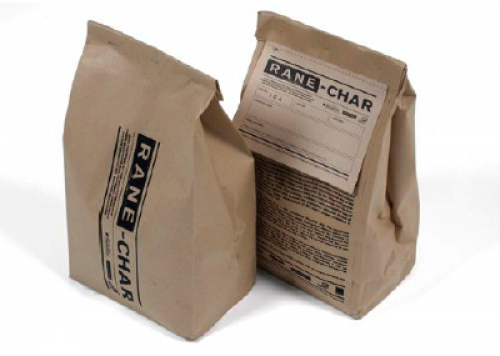
The RANE-CHAR project uses organic charcoal production as an artistic strategy to raise awareness of the threat of climate change.
When trees are cut down, used as firewood or left to decompose, most of the carbon dioxide absorbed by the trees during
their life returns in the atmosphere. If, on the other hand, the plant material is transformed into charcoal, a large part of this carbon remains in a stable form that prevents it from escaping. This process, which consists in transforming organic matter into “bio-char” (like charcoal), known as pyrolysis, allows the vegetable matter to burn at high temperature in the absence of oxygen. Bio-char, which potentially mitigates climate change by reducing the amount of carbon in the atmosphere and keeping it in the soil, also has unique properties that help maintain healthy soil.
The work is presented in four different forms:
1. The pyrolysis of the wood during a public intervention and the packaging of the “bio-char” produced in 1kg bags which will be the work itself.
2. Distribution of individual and unique RANE CHAR bags with a postcard. Members of the public intervene by burying the contents and returning the postcard to the RANE research group who record and locate online where the “bio-char” is buried.
3. A transport case containing the RANE CHAR bags designed to be displayed.
4. A public lecture by Dr. Daro Montag, using charcoal produced during the project to illustrate the links between energy, economy and environment that are driving our culture into crisis.
Daro Montag was born in 1959. He lives and works in Falmouth, UK.
KRIESLAUF from DAS NUMEN
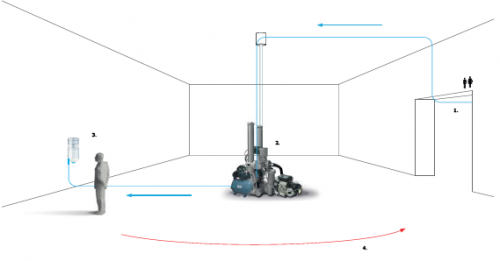
The Krieslauf project (circuit) is a technical installation based on filters that proposes to purify the wastewater generated in the course of an exhibition and to produce drinking water, all on site and in a process that is part of the exhibition.
A sort of catalyst purifying the secretions of the exhibition, and then refreshing the visitors, the Krieslauf proposes a complete cycle of digestion / secretion /
cleaning.
Through this system, an unexpected link is proposed between toilet water and tap water. It is then possible to drink water that has been soiled beforehand. For that a system of separation between the solid elements (excrements) and liquids (urines) is made at the base in the toilets, the solid part is dried, the liquid part is then filtered by natural mechanisms (membranes, UV light, chlorofication). The mechanism is partly made visible to the visitor who thus becomes aware of the natural mechanisms in response to the demands of hygiene and the need for resources.
The objective is to generate awareness through an experience that places nature in a surprising, disturbing, intimate, atypical and magical creation within a Western culture that has forgotten how powerful, evocative and local nature’s services can be.
Das Numen is a collective created in 2009. Its members live and work in Berlin, Germany.
SUPERMEAL by ERIK SJÖDIN
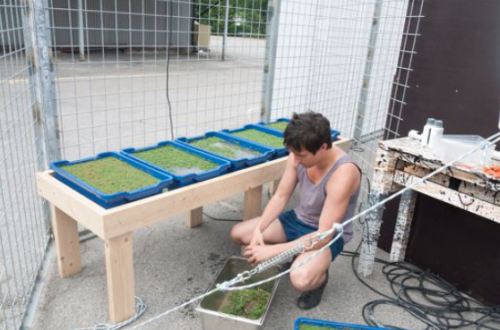
The Azolla aquatic plant can do just about anything: replace chemical fertilizers, serve as food, prevent malaria and open up space. It may even be a regulator of the Earth’s climate. This plant, with its unique growth rate is also an important source of nutrients. However, it is not part of our daily diet.
In Super Meal, Erik Sjödin experiments with farmers, chefs and scientists on the use of Azolla in food and reflects on how we produce and will produce our food in the future. The project includes Azolla cultivation, workshops and cooking classes, cooking sessions and meals
shared in the public space.
Super Meal is developed with the help of John Larsson from the botanical department of Stockholm University, Masamichi Yamashita from the department of Biology and Space Agriculture of the scientific branch of JAXA (Japan), the art and agricultural collective Kultivator from Öland (Sweden), the contemporary art and architecture space Färgfabriken in Stockholm and Oloph Fritzen, farmer in the only urban farm in Stockholm.
Erik Sjödin was born in 1979. He lives and works in Arsta, Sweden.
TOPIC-WATER by ISABELLE DAËRON
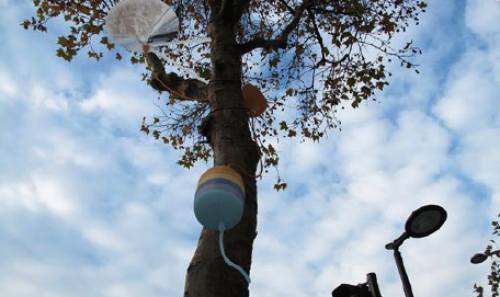
In the 19th century, the water collection network was set up in Paris, a unified network was adopted. This system combines rainwater and water in a single pipe
This reduces the cost of conducting the flows. However, as the volume of water to be treated increases, it now seems inappropriate. Rainwater mixes with wastewater and is treated in wastewater treatment plants, whereas rainwater requires much less filtration.
The networks imply a dependence on a technical system, they disconnect the city dweller from their living environment. Thinking about the organization of flows in relation to the mobility of tomorrow’s users means proposing autonomous, transportable objects that allow resources to be used on the spot.
Topique-eau is a fountain disconnected from the hydraulic network and connected to the environment that takes advantage of the qualities of the place (rainfall, existing physical elements such as trees or poles, etc.) to offer drinking water. This fountain is a sign addressed to the citizens: it tells the story of the transformation of a resource – rainwater – from its capture to its storage and filtration until its use by the users of the place.
Isabelle Daëron was born in 1983. She lives and works in Paris, France.
THE INFINITY CUBE LAB by JAE RHIM LEE
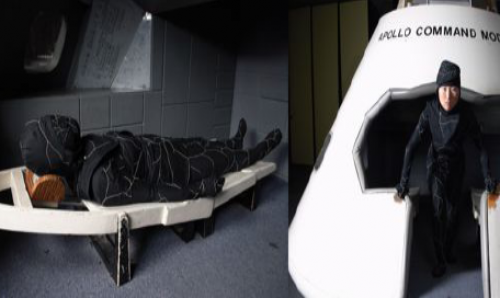
TheInfinity Burial Project is a modest proposal for an alternative to the treatment of postmortem bodies that promotes and facilitates individual engagement in the process of decomposition, a challenge to the denial of death and environmental degradation inherent in Western postmortem practices.
This project is based on the development of a unique variety of mushroom, the Infinity Mushroom, which breaks down and removes toxins from human tissue. He offers a decomposition “kit”, a funeral suit equipped with decomposition activators and runs an association dedicated to promoting awareness, acceptance of death and the practice of “decompiculture” (cultivation of organisms acting in the decomposition process).
The Infinity CubeLab is a laboratory module developed for the International Space Station for scientific research on the effects and potential of microgravity. The Infinity CubeLab aims to test the viability of theInfinity Mushroom as a biofilm and human tissue digester in microgravity and to provide a solution to the issue of waste and burial in space.
Jae Rhim Lee proposes the installation of a human-scale Infinity CubeLab. Its transparent surface is coated with biofilm and fungi. Temperature and humidity sensors, as well as a camera, allow us to observe the activities and interactions between the biofilm and the fungi. A reflection game projects the observers “inside” the Cubelab, suggesting that they too will one day be digested.
Jae Rhim Lee was born in 1975 in Gwangju, South Korea. She lives and works in Massachusetts, USA.
PERPETUAL AMAZONIA by LUCY + JORGE ORTA
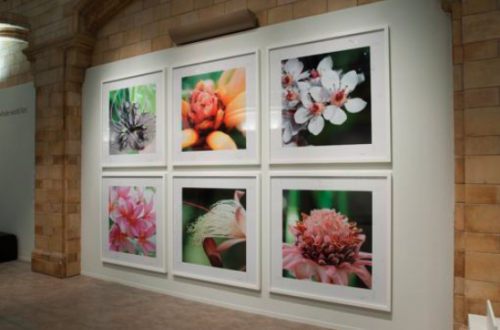
In 2009 and 2010 the duo created Amazonia for the Natural History Museum in London. In the spirit of “exploration trips”, the works produced retrace their expedition undertaken in the Peruvian Amazonian forest in the summer of 2009 with Cape Farewell, around biodiversity. Lucy+Jorge Orta plan to present in France the second part of this work with Perpetual Amazonia (MLC Plot 00,0001 I one meter | S12 48 21.6 W71 24 17.6) A photographic, relational and participative work, involved in the process of studying and saving the Amazonian forest.
During their expedition, alongside the scientists, the artists recorded and photographed all the flora and fauna they encountered on a one hectare plot in the Manu forest (GPS S12 48 21.6 W71 24 17.6). They then divided this hectare into 10,000 subplots of one meter by one meter, identified by their exact GPS coordinates. Each photograph is a poetic representation of each plot. They are accompanied by a 60-year certificate of moral ownership, granting the right to protect the forest, to contribute to research and to pass this certificate and the accompanying photograph on to the next generation.
The installation Perpetual Amazonia engages the participation of the public through the distribution of a “relational” poster inviting the public to get involved in the issue of forests and to raise funds for scientific research in the Amazon.
Lucy Orta was born in 1966 in England and Jorge Orta in 1953 in Argentina. They live and work in Paris, France.
ARCTIC CONQUISTADORS by OLGA KISSELEVA
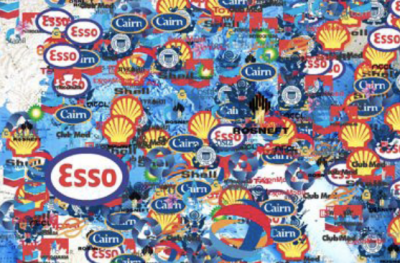
Arctic Conquistadors is an interactive map of the North Pole, generated in real time. By tracking the companies that set up shop daily in the polar region, this original program, developed by Olga Kisseleva in collaboration with geopolitical researchers, puts into perspective the possible economic conflicts of this new El Dorado. The artist has built a program that analyzes situations in real time and makes companies appear on the map of the Arctic where they are being established.
On the screen, a map of the Arctic. Logos of mainly oil groups such as Shell, Esso, Total, Tschudi, appear there as time goes by. The rhythm accelerates, the logos are superimposed faster and faster, pile up, pile up until they overflow the screen: the program starts to go crazy by itself. In the end, it explodes, it becomes unbearable.
This work is a warning against the risks that threaten this region rich in oil reserves and still little exploited.
After the wars of religion, the wars of empires, the political wars, we are now witnessing the war of markets between multinationals. Most of the political problems stem from this new division of the world.
Olga Kisseleva was born in Leningrad in 1965. She lives and works in Paris and Saint Petersburg.
DAMMED WATERS by PETER FEND
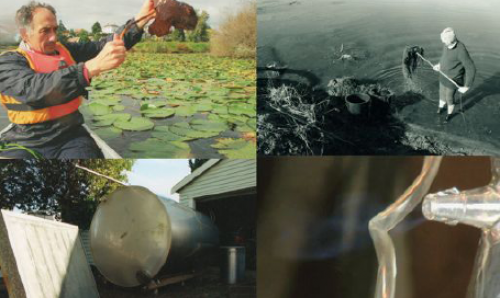
Peter Fend proposes to design simple equipment to collect aquatic plants that proliferate in canals and reservoirs to produce biogas quickly and locally, without pressuring bacteria, harming birds and fish, and re-growing plants while helping to restore aquatic ecosystems. This equipment uses only human energy.
Once harvested, the plants are macerated, cow dung and grass cuttings are added, then silage and ferment: after a period ranging from three days to three weeks, gas is obtained.
Combining Duchamp’s Fountain and Beuys’ fat, Peter Fend has focused his work on the production of “zero emission” hydrocarbons from plants
aquatic. He chose to focus on standing waters rather than oceans because they have the advantage of being politically autonomous and forming
stable and well identified ecosystems. Peter Fend is conducting this research in Holland, a country of dykes par excellence.
Once the technique is proven, he plans to develop similar sites on fish and bird migration routes in Scandinavia, the Mediterranean basin and beyond. In these restored aquatic environments, birds return and disperse seeds and guano, in turn restoring forests and other ecosystems. Art becomes that by which “Nature produces more Nature” (Spenser).
Peter Fend was born in 1950 in Columbus, USA. Lives and works in Berlin, Germany.
MARBLE FROM HERE by STEFAN SHANKLAND
The Marbre d’Ici project is led by visual artist Stefan Shankland, with Raum architects, Matériaupôle, Urbicus paysagistes and the TRANS305 team.
Initiated in 2007 by Stefan Shankland, the HQAC (High Quality Artistic and Cultural) approach aims to integrate an artistic and cultural dimension into an urban transformation process. The ZAC du Plateau in Ivry-sur-Seine (94) is the field of application of this approach combining art, city and sustainable development. The TRANS305 program, HQAC prototype, associates artists, residents, urban professionals, students, researchers, cultural actors, city services and elected officials in the creation of a new culture of the changing city.
The Marbre d’Ici project brings together artistic, urbanistic and environmental issues. Based atAtelier / TRANS305, the project team is involved in the design and production of the future public spaces of the ZAC. The objective is to create a new composite material (Marbre d’Ici) made from rubble from the construction sites of the ZAC: a local raw material, bearing the history of a neighborhood, enhanced through an artistic process. Marbre d’Ici will be used to replace other imported materials (granite, marble…) and contribute to the aesthetic and cultural identity of a neighborhood in the making.
In April 2012, Marbre d’Ici will be integrated into the first public space of the ZAC, located at the site of the current Atelier / TRANS305.
Stefan Shankland was born in 1967 in Paris. He lives and works in Ivry-Sur-Seine and Berlin.
JALAN JATI by THE MIGRANT ECOLOGIES PROJECT
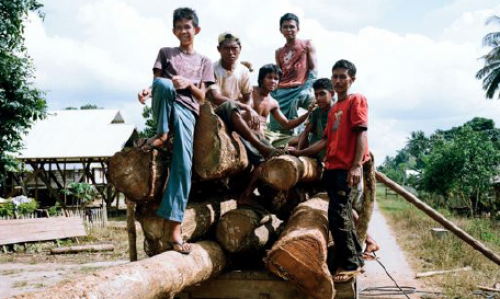
Jalan Jati or “The Teak Road” traces the original, material and poetic journey of a teak bed found in a second hand “karang guni” store in Singapore, from the place in South East Asia where the original tree grew. The project confronts cross-cultural natural histories, micro- and macro-level tree relationships, and the technique of wood traceability through DNA sampling.
Each tree has a unique DNA identity which is antropomorphically called a “fingerprint”. DNA technology can therefore be used to ensure that the wood purchased by international consumers comes from plantations and not from primary forests. Jalan Jati is part of an ongoing research on human relationships to trees, forests and forest products in Southeast Asia, focusing on materials, metaphors, magic, ecological resources and historical hazards. The artistic approach includes photographs, collages of wood and bed prints, and stop-motion animations.
Preliminary tests suggest a possible compatibility between the DNA of the famous bed and South Sulawesi teak. A group of artists and scientists have visited the ancient teak plantations of Muna Island in Southwest Sulawesi and are recreating an “ecology” based on elements of social and esoteric narratives combined with information gathered from the wood grain of the bed.
The Migrant Ecologies Project is a collective composed of Lucy Davis, Shannon Lee Castleman and their collaborators, based in Singapore.
At a time when knowledge alone is no longer enough to motivate action, the Prix COAL 2024 calls for transformation…
For its fifth edition, the student COAL Prize is focused on transformation, in partnership with France’s Nature Reserves.
COAL’s 15th anniversary event for creative artists committed to ecology. December 6, at the Musée de la Chasse et de…
